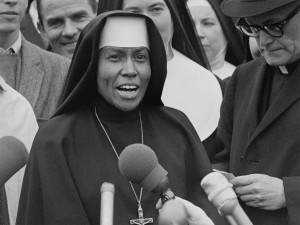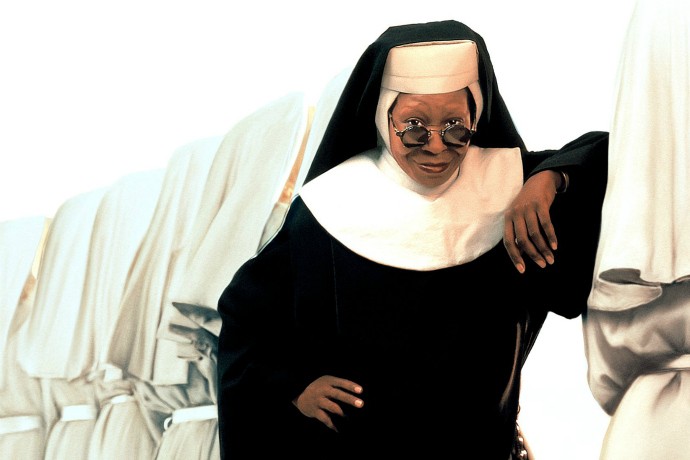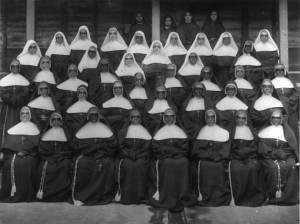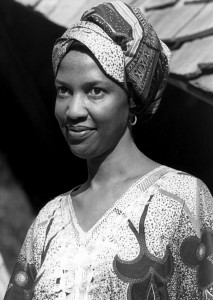When news of Disney’s plan to reboot its wildly successful Sister Act franchise broke last week, media and fan reactions were as swift as they were predictable.
From TIME to The Guardian, divinely inspired headlines cheered the impending reincarnation of America’s favorite black Catholic nun and choir director on the silver screen. Some even began speculating about who among today’s leading black actresses might replace Oscar-winner Whoopi Goldberg, who starred in the first two Sister Act films and produced its Tony-award winning musical incarnation.
However, not all are excited about the forthcoming addition to Disney’s platinum brand.
On Twitter, diehard Sister Act fans have vehemently objected to the remake, calling it “a mistake” and “pure sacrilege.”
Matt Stopera over at Buzzfeed went even further. In an article titled, “Why the ‘Sister Act’ Films are the Most Important Films of Our Times,” Stopera called plans for the remake a “sin” and credited the 1992 smash hit original and its 1993 sequel with making him “a better Catholic.”
Why, you ask? “[Because] they just felt like real nuns,” Stopera wrote.
Now to preface, I am a cradle Catholic and a huge fan of the Sister Act films. I have also spent the last nine years researching the history of black female religious life and interviewing scores of elderly black women who desegregated the nation’s historically white Catholic sisterhoods in the 20th century.
If Sister Mary Clarence and her soulful band of singing white nuns are testaments to any historical truth of U.S. Catholic female religious life, then I am the Queen of England, the President of the People’s Republic of China, and the lost ruler of Zamunda rolled all into one.
While angry reactions to remade classic films are understandable, the notion that Sister Act ever should be taken as anything more serious than Hollywood entertainment is downright ludicrous. It also cannot go unchallenged, not only for the sake of sanity, but also out of respect to the long and fiercely-contested history of black Catholic nuns in the Atlantic world.
Since the 1st century, thousands upon thousands of black women and girls have professed the sacred vows of poverty, chastity, and obedience in the Roman Catholic Church. However, the church’s longstanding practices of racial segregation and exclusion in religious life kept the global population of black Catholic sisters low and statistically insignificant in various parts of the world well into the twentieth century.
In the United States, for example, white Catholic sisterhoods were among the fiercest strongholds of racial segregation and white supremacy. The majority of white orders remained staunchly opposed to the integration of their ranks through America’s Civil Rights movement well into the 1960s, and most never had a single perpetually professed U.S.-born black sister in all of the 20th century. Moreover, archival records and oral history reveal that many pioneering black sisters in white congregations endured years of racial harassment, verbal abuse, emotional isolation, and daily humiliation.
Some, such as the first black Sisters of St. Mary (now the Franciscan Sisters of Mary) in St. Louis, Missouri, initially had to enter the backdoors of their motherhouse and profess their vows separately from their white counterparts. Many other black sisters had their ministries severely limited because their white counterparts refused to live and dine with them on a non-segregated basis or because the communities in which their congregations labored fiercely opposed the presence of black nuns.
Many black sisters in white congregations also endured intense pressure to deny and degrade their racial heritage in order to feel accepted by their communities. Some even admitted to praying to become white in order to stop the incessant bullying and racist name calling of their white counterparts. As Sister of the Blessed Sacrament Christine Nesmith aptly put it in 1971,
“Entering an order meant ceasing to be black and looking on what you grew up with as uncouth. You could do the Irish jig, but anything African was taboo.”
Such abuse and the prolonged intractability of white supremacy in female religious life eventually drove scores of black sisters out their communities in the late 1960s and 1970s, decimating their already marginal national population. While some black sisters left on their own accord or defected in explicit protest to racial discrimination, many others in temporary vows were summarily dismissed from their communities as a result of their political activism and willingness to testify publicly about their experiences of racist and sexist abuse in the church. Consequently, black sisters in white congregations (whether they persevered or not) routinely have been subject to historical erasure, marginalization, and myth-making.
Indeed, it should give everyone pause that the world’s most famous and beloved black nun is a fictional character instead of an actual black sister-saint. It should also come as no surprise to discover that the character of Sister Mary Clarence was very loosely based on the life of an actual black nun, who fought to revolutionize Catholic masses by incorporating sacred African-American cultural and spiritual traditions.
In 1970s and 1980s, pioneer African-American Franciscan Sister of Perpetual Adoration Thea Bowman took the U.S. Catholic church by storm with her public opposition to Catholic divestment from inner-city communities and her revolutionary ministry, which masterfully combined African-American storytelling, preaching, dancing, and singing. At the time of her death from bone cancer in 1990, Sister Thea, then only 52 years old, was arguably the most famous Catholic sister in America. Goldberg even was planning to produce a documentary about Sister Thea’s life.
That Sister Thea, who held doctorates in English and theology from the Catholic University of America and Boston College respectively, and whose cause for canonization, i.e. “sainthood,” is making its way through Vatican channels, could be reduced to the morally ambiguous character of Delores Van Cartier in the hands of white Hollywood producers is a tragedy.
That Sister Act remains the chief reference point for the vast majority of conversations about black Catholic nuns and the integration of female religious life is even worse.
While some may argue that the Sister Act films have helped to mitigate longstanding white opposition to black sisters and the casting of black women as nuns in Hollywood, the racist backlash to Audra McDonald’s scene-stealing performance as Mother Abbess in NBC’s 2013 live remake of The Sound of Music suggests otherwise.
Moreover, black sisters’ 2,000–plus years of history and the unprecedented growth of the global black nun population over the last 50 years demand that we begin making different kinds of films about black nuns, Kari Skogland’s made-for-television Courage to Love (2000) notwithstanding. We must also never miss an opportunity to include them in movies where they rightfully belong.
For example, two pioneer African-American nuns, Franciscan Sister of Mary Antona (Elizabeth Louise) Ebo and Sister of St. Joseph Ann Benedict (Barbara) Moore, were among the handful of Catholic nuns who traveled to Selma, Ala., to join the game-changing voting rights marches in 1965. In fact, Sister Mary Antona was in the first delegation of sisters to arrive in Selma, and she delivered an impassioned address to the national media when some questioned whether she was in fact “a Negro” and a nun.
Yet Sisters Mary Antona and Barbara conspicuously are absent from the Academy-award nominated film Selma, as are sisters such as Pittsburgh’s M. Martin de Porres (Patricia Muriel) Grey, R.S.M. who founded the radical National Black Sisters’ Conference in 1968. Although Grey’s superiors explicitly forbade her from traveling to Selma to participate in 1965 demonstrations, she led a delegation of students from her community’s Mount Mercy College (now Carlow University) in a Selma sympathy march through the streets of downtown Pittsburgh on March 16, 1965.

Sister Mary Antona Ebo speaks at a Civil Rights march in Selma, Ala., in 1965. Archive photo via the documentary film “Sisters of Selma.”
That the black sisters who traveled to Selma and participated in solidarity marches across the nation at the same time were subjected to racial discrimination in their congregations undoubtedly fueled their determination to respond to King’s clarion call. Many in their position had already demonstrated an uncommon faithfulness by refusing to abandon their vocations in the face of whites-only admissions policies and traveling hundreds, if not thousands, of miles from their hometowns to enter communities that would accept “Negroes.”
This same indomitable faith and perseverance also enabled members of the nation’s black sisterhoods (established by black women in the 19th and early 20thcenturies to ensure the development of black female religious life in the Western world) routinely to turn the other cheek when white Americans, Catholic and non-Catholic alike, pushed them off sidewalks, ripped their habits from their heads, or threatened their convents and schools with violence during America’s slave and Jim Crow years.
The names of these courageous black women of God deserve to be better known than the fictional Mary Clarence, and we should take every opportunity to tell their stories of faith in the face of unholy discrimination in any way that we can—especially on film.
Their history—the real sister act, if I may—is a far more compelling drama anyway.




